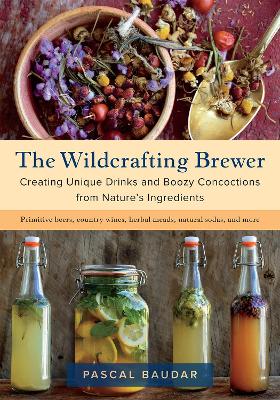Reviewed by annieb123 on
Due out 12th Feb, 2018 from author Pascal Baudar and Chelsea Green Publishing The Wildcrafting Brewer is both a workbook and primer along with a healthy dose of anthropology and oral history. It's a weird and very entertaining book full of guidance and experience.
The first chapters introduce the concept of wildcrafting in relationship to brewing along with a general introduction to beers, meads, sodas, wines, and hybrid concoctions which defy categorization. The author spends a great deal of time explaining safe gathering and brewing methods as well as preparing the gathered materials for use in brewing.
About 15% of the content is spent defining the history and methodology of brewing covering equipment and supplies as well as different types of sugars (gotta feed those yeasts and turn the sugars into alcohol).
Next he delves into a study of finding and sourcing yeasts and what the different sorts of yeasts and starters can add to homebrews. All yeasts are not created equal and the author provides a guide for tweaking and adjusting the sugar content to best suit the type of yeast which is being used. As an example, wild yeasts from homemade starter are generally less resistant to alcohol, so they die off at a lower alcohol percentage. If you use a recipe tweaked for a champagne yeast, which is hardy to up to 15% alcohol by volume, the wild yeast will die off long before all the sugars are converted in the wort, leaving an overly sweet resultant brew.
The yeast chapter is especially interesting and thorough, and encourages reflection and experimentation. The entire book has an encouraging DIY feel, but I especially appreciated the interesting aspects of sourcing and finding wild yeasts and making starters from wildcrafted supplies.
The book progresses through adding flavors and different methods for brewing as well as a relatively exhaustive look at sugars and sources, to finding (or making) different types of less processed and refined sugar in wildcrafted brewing.
The specific categories of brews; beers, wines and meads, ethnic drinks and medicinal brews, and sodas get their own chapters with a fairly exhaustive look at each group.
The book closes with an resource list and recipe index.
As a homebrewer, I've never used wildcrafted ingredients in my brews, apart from honey (I'm a beekeeper) and homegrown fruit (I'm a gardener). This book is not really for the 'blind follower' or for the brewer who's interested in cookie cutter brewing which will give identical results consistently. It is, however, a guided look at primitive brewing with wildcrafted ingredients along with a heaping dose of historical reference to our ancient connection with brewed and fermented drinks.
Definitely out of the ordinary, but well researched and beautifully photographed.
Four stars
Disclosure: I received an ARC at no cost from the author/publisher.
Reading updates
- Started reading
- Finished reading
- 11 November, 2017: Reviewed
